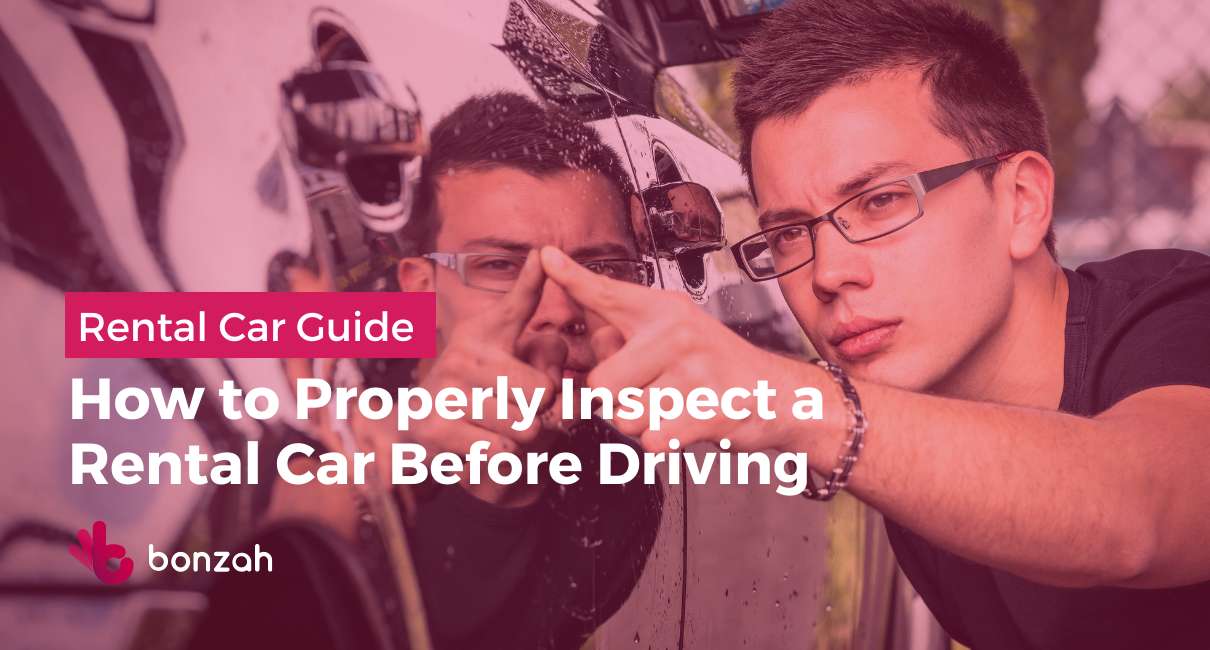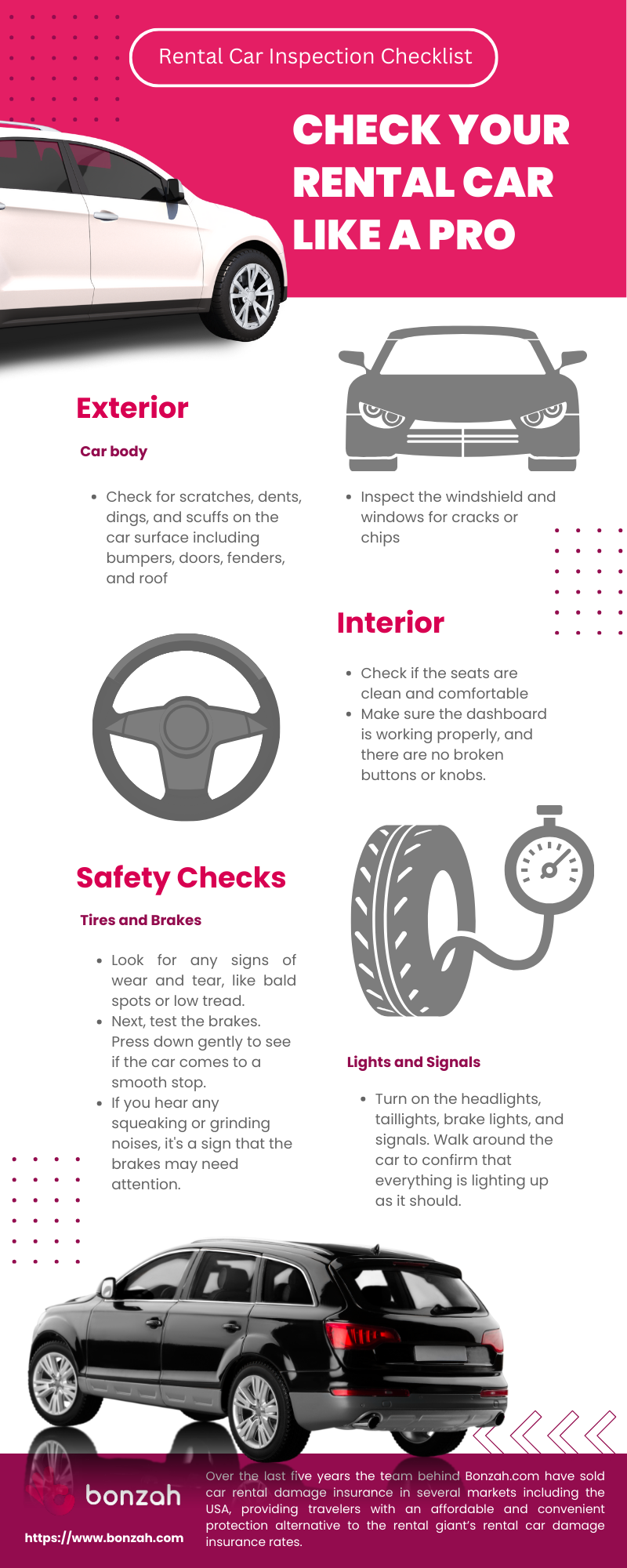
Renting a car for your next adventure? Ensuring it's in good condition before hitting the road is crucial. Follow this quick guide to inspect your rental car properly and avoid any unexpected issues during your journey.
Why inspecting a rental car is important
Inspecting a rental car before driving off might seem like a hassle, but it’s crucial for various reasons. For one, it will help protect you from being charged for pre-existing damage. Second, it will guarantee that you drive a safe and well-maintained vehicle.
Taking a few minutes to inspect a rental car from all angles can save you time and money in potential repairs or unwarranted charges. It safeguards your safety while providing peace of mind throughout your journey. So make sure you allocate ample time for the inspection. Rushing through this process may cause you to miss important details.

Pre-inspection checklist: Exterior condition of the car
The rental car pre-inspection checklist is crucial to ensure that the exterior condition of the vehicle is properly documented before the rental period begins. This helps protect both the renter and the rental company from any disputes regarding damages that may occur during the rental period.
Start by examining the rental car's exterior. Look for scratches, dents, or any visible damage.
Pay extra attention to:
- Bumpers
- Doors
- Mirrors
- Roof
- Trunk
Check the Windows and Mirrors: Inspect the windows for cracks, chips, or any damage. Ensure all mirrors are properly adjusted for optimal visibility. Check for any chips or cracks in the windshield, as they can obstruct visibility and potentially lead to further damage if not addressed promptly. Also, look out for loose or missing parts such as side mirror covers or door handles.
Check the Tires: Inspect the tires for proper inflation and tread depth. Uneven wear could indicate alignment issues. Adequate tire condition is crucial for safe driving and prevents potential blowouts or accidents due to poor traction.
Lights and Signals: Ensure that all lights are functioning properly including headlights, brake lights, turn signals, and hazard lights. Faulty lights can be a safety hazard and may also result in fines from law enforcement.
Look underneath the car for any leaks or excessive rust which could indicate underlying mechanical issues.
Interior inspection checklist
Once you’re done with the exterior, you can move to the car’s interior to assess the vehicle for any damages or cleanliness issues.
Begin by checking the overall condition of the interior, paying close attention to any signs of excessive wear and tear.
Inspect the seats: Check the seats for stains, rips, or tears, and ensure they are properly adjusted and functioning. Take note of any foul smells or odors that may need to be addressed.
Dashboard and console: Next, inspect the dashboard and console area for any cosmetic or functional defects. Look for scratches, cracks, or missing components such as knobs or buttons. Ensure all dashboard lights turn on and then off when starting the engine. Look for any warning indicators.
Double-Check the Fuel Gauge: Confirm the fuel level matches what's indicated on the rental agreement.
Technology and Accessories: Test all electronic features including lights, air conditioning, stereo system, and power windows to ensure they are in good working condition. Test infotainment systems, GPS, and other accessories that come with the car.
Check the carpets and mats: Examine the cleanliness of the carpeting and floor mats throughout the car. Check for any dirt, stains, or spills that may require attention. Inspect the trunk space as well to ensure it is clean and free of debris.
Inspect the steering. Check the condition of the steering wheel and gear shift knob for any damage or excessive wear. Verify that all control buttons on the steering wheel are functioning correctly.
Lastly, check all safety features such as seat belts and airbags to confirm they are intact and operational. Take note of any warning lights on the instrument panel that could indicate potential issues with these features.
More inspection items
Don't forget to look under the hood! Inspect fluid levels including oil, coolant, brake fluid, and washer fluid before setting off on your journey. It is also prudent to verify that tires are properly inflated and have adequate tread depth for safe driving conditions.
Familiarize yourself with any additional tools or accessories that come with the rental vehicle such as spare tire kit or roadside emergency supplies.
If you find any damage or issues, document them using your smartphone's camera. Note down any missing items or malfunctioning equipment so you won't be charged for them upon returning the car. If you find significant damage that wasn't documented, notify the rental company immediately.
Before leaving the rental lot, review the rental agreement and note any existing damage or issues.
Avoid rental car headaches with a thorough inspection
Properly inspecting your rental car ensures your safety and peace of mind during your journey. Don't rush through this step – a thorough inspection can help you avoid potential hassles later on.
By thoroughly examining these aspects during a pre-inspection checklist, both renters and rental companies can avoid disagreements over damages before commencing with an enjoyable and stress-free rental experience.
P.S. And to get total peace of mind on your journey, make sure you’re covered with Bonzah rental car insurance!